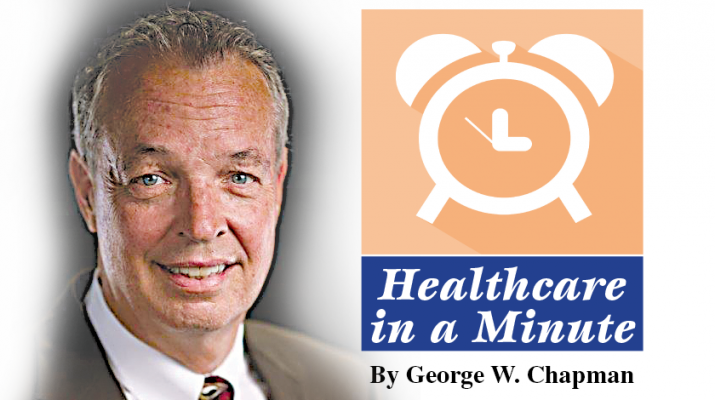Physicians Rated: Patients Give Their Doctors 4 Out of 5 Stars
By George W. Chapman
The online ratings site “Healthgrades” and the Medical Group Management Association collaborated on a survey to determine what people think of their physician. Close to 7 million people went online to rate over 1 million physicians. The bottom line is that people don’t just want to see a physician, they want to be seen. People care about both the clinical and patient experiences as essential to a positive encounter with their provider. Fifty percent of people cited at least one of these factors as important: compassion, comfort, patience, personality and bedside manner. Twenty-three percent cited at least one of these factors as important: knowledge, time, insurance, appointment scheduling and communication.
There was little difference in physician ratings by gender. Overall, respondents were very happy with their physician giving an average rating of four out of five stars. In open comments, the interaction with staff was critical to a positive experience.
Walmart Getting Into the Act
Hopefully, the physician practices that belong to the Medical Group Management Association will take heed of the above survey results. Physician- and hospital-sponsored primary care practices are under assault. Large corporations see an opportunity and are keenly attuned to consumer trends and desires. Not to be outdone by the announced mergers of Cigna/Express Scripts and Aetna/CVS, Walmart announced a possible deal with insurer Humana. Walmart would pay Humana around $37 billion. All three merger partners have said the improvements in access to convenient community-based care far outweighs concerns about hurting competition. They claim they are responding to what consumers want, implying physician and hospital sponsored practices are failing to meet the grade. Just a few weeks ago Amazon, JP Morgan Chase and Berkshire Hathaway announced a potential joint healthcare venture.
Fraud Down
The DOJ and HHS recovered $2.6 billion in fraudulent claims last year. This is a decline of 21 percent from the previous year because stricter enforcement efforts are making it harder to get away with fraud. The joint anti-fraud effort has a recovery to expense ratio of 5 to 1. In other words, the government spends $1 to recover $5. Last year, the government (DOJ/DEA) created an opioid fraud unit. In just a couple of months, the DEA revoked the controlled substance license of 147 prescribers. The DEA is focusing on prescribers and pharmacies that dispense disproportionate amounts of controlled substances. The DOJ is seeking special permission from the courts to participate in settling lawsuits filed by states against opioid manufacturers and drug distributors.
Superbugs Are Here
Seemingly right out of some dystopian science fiction novel, the Centers for Disease Control has discovered hundreds of antibiotic-resistant superbugs. The CDC’s Antibiotic Resistance Lab found 221 bacteria that could not be killed by any or most known agents. It costs us $2 billion per year to combat these superbugs which, if uncontained, are on track to kill more people than cancer by 2050. The CDC has issued containment strategies to healthcare facilities, emphasizing the need for quick identification of superbug cases including regular internal infection control assessments. People most at risk for spreading infections are people who have recently traveled or were treated elsewhere.
Healthcare Cost Study Confusing
There is no argument: US healthcare costs too much. A recent study published in JAMA, Journal of the American Medical Society hypothesized that our exceedingly high cost per capita of care ($10,000-plus) is not because of too many doctor visits, hospitalizations, procedures and tests. Researchers concluded it’s the cost of these services that create the overall high cost of care compared to virtually every other country. No kidding! Their reasoning is specious. Americans don’t see their doctor as much and have fewer procedures versus other countries because costs are prohibitive. Our notoriously high deductibles and copays serve as disincentives to seek care. So the volume of services we consume is artificially low due to high out-of-pocket responsibilities. Citizens of other developed countries don’t face our financial barriers and see their providers more often. The result is better outcomes.
Healthcare Success
Success in healthcare emanates from an active partnership between provider and patient. Neither partner can say they “owe it all” to the other. There are seven things patients can do to be a better partner in their care.
1. Ask questions about tests, procedures, treatment plan, medications even the provider’s experience. Be clear on what the game plan is.
2. Know what’s in your record. The information belongs to you. Most of us now have electronic records and most practices offer access through an online portal.
3. Be prepared for your appointment. Do your homework. Know your family history and your medications. It doesn’t hurt to go online and research your symptoms or illness.
4. Be open and honest. It doesn’t help to sugarcoat things like the medications, vices or bad habits.
5. Be committed to the game plan. There can’t be success without your participation and buy in.
6. Seek “well” care, not just “sick” care. When you’re in the exam room because your aren’t well, the provider’s focus will be on only that. There is little time to discuss or review your master plan.
7. Keep your appointment. Life is full of surprises and unplanned events; so when one occurs please call the office and reschedule! The quickest way to fall from grace with any provider is to be a “no show”.
George W. Chapman is a healthcare business consultant who works exclusively with physicians, hospitals and healthcare organizations. He operates GW Chapman Consulting based in Syracuse. Email him at gwc@gwchapmanconsulting.com.

